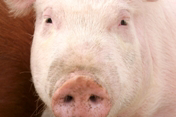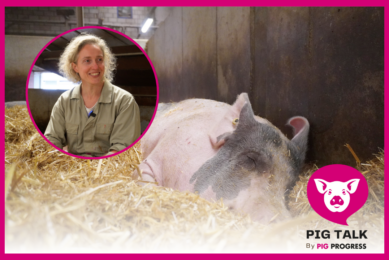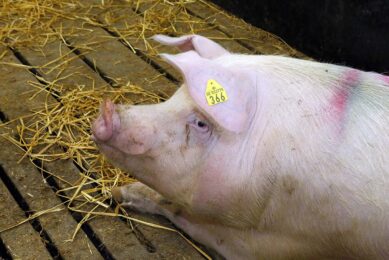Reverse heating system for chilling pigs in summertime

Using a reverse heating system might help to reduce heat stress for finisher pigs in summertime, Swedish research has indicated.
The research was presented at this year’s International Pig Veterinary Society (IPVS) Congress in Cancún, Mexico. The researchers state that growing pigs to market weight in temperatured zones has mainly focused on maintaining comfortable temperatures during wintertime, adding that also in temperatured zones risk for side effects due to Temperature-Humidity Indexes (THI) above 25 may arise in summertime.
The aim of the study was to evaluate the potential of running the heating system backwards during the summer with the aim to accomplish a more comfortable indoor climate.
Integrated herd
The study was made in an integrated herd with a module stable for finishers with a natural mechanic ventilation system (www.nyborghuse.dk). Each unit had two pens sized 19.6 m2, out of which 5.7 m2 was a dunging area located outdoors. Each pen housed 20 pigs (0.98 m2 per pig). Pigs entered the stable at 12 weeks of age and were reared to market weight all in-all out.
Temperature and relative air humidity were monitored and Temperature-Humidity Indexes (THI) were established.
Summer batches from three years were compared. In 2010, no attempt to chill was made. In the summer of 2012 a heat exchanger with a high effect was installed and connected to the water-based heating system of floors, running from July 18 in 2012 and from May 28 in 2013.
Results
The mean outdoor temperatures ranged within 3°C between the three years. The summer 2012 was coldest and the outdoor THI was lowest that year. Despite this, the mean indoor temperatures and THI-values were equal.
| Table 1: Study periods during the years and mean climate conditions during the study periods. | |||
| 2010 | 2012 | 2013 | |
| Same period | May-July | July-Sept | June-Aug |
| Outdoors** | |||
| Temp (°C) | 19.6±5.4 | 17.3±4.4 | 20.1±3.1 |
| Humidity (%) | 48.3±11.5 | 74.2±14.3 | 55.0±9.2 |
| THI | 18.1±3.9 | 16.7±3.3 | 18.8±2.3 |
| THI-max | 22.8 | 22.7 | 21.6 |
| Indoors** | |||
| Temp (°C) | 24.0±2.8 | 23.3±1.5 | 23.6±1.7 |
| Floor temp (°C) | 26.2±1.7 | 25.3±1.4 | 26.3±0.8 |
| Humidity (%) | 49.4±9.6 | 70.0±8.2 | 56.2±5.5 |
| THI | 21.4±2.3 | 21.9±1.3 | 21.4±1.5 |
| THI-max | 28.8 | 25.1 | 23.3 |
| Indoors** | |||
| 16.00-19.00 | |||
| Temp | 24.0±2.8 | 23.3±1.5 | 23.6±1.7 |
| Floor temp | 26.3±1.8 | 25.3±1.4 | 26.3±0.8 |
| Humidity | 47.6±8.9 | 65.8±9.4 | 54.3±7.3 |
| THI | 22.1±2.7 | 22.4±1.4 | 22.1±1.7 |
| THI-max | 25.5 | 25.5 | 23.9 |
| **= mean of whole day (from 7.00 to 19.00) | |||
In 2013, the water from the heat exchanger increased with approximately 2°C from entering to leaving the finishing stable at 8 am and with about 1.6°C at 4 pm, indicating an absorbance of heat from the concrete floor (Table 2). The mean floor temperature was 1°C lower in 2012 compared 2012, but equally high in 2013 as in 2010 (Table 1).
| Table 2: Mean temperatures of water in the heating system during 2013 | |||
| Into stable | From stable | Difference | |
| Am (°C) | 24.2±0.8 | 26.2±0.8 | 2.0±1.1 |
| Pm (°C) | 24.7±1.0 | 26.3±0.5 | 1.6±1.0 |
The mean THI levels were below the critical value of 25 during all years. Maximal THI values above 25, however, were denoted in 2010 and 2012, but not during 2013. The mean indoor temperatures were constantly 1°C higher in the late afternoon. Thus, also the highest THI values were recorded in the afternoons (Table 1).
Conclusions
As the top THI values obtained in 2010 and 2012 exceeded 25, the results confirmed the risk for heat stress of pigs also in temperatured zones. Chilling floors could be a way to deal with this, but the results obtained indicated the need for high efficacy of such systems.
Obviously the concrete floors accumulate heat, which probably also makes the time point of initiating chilling critical and the impact of that will be further scrutinised.
Despite the failure to document a true decrease in floor temperature, a possible positive effect was indicated since THI-values above 25°C not were recorded in 2013.
The research was carried out by P Wallgren and M Zoric from the Swedish National Veterinary Institute (SVA) in Uppsala and SE Johansson from Nibble, in Västeräs, Sweden.











